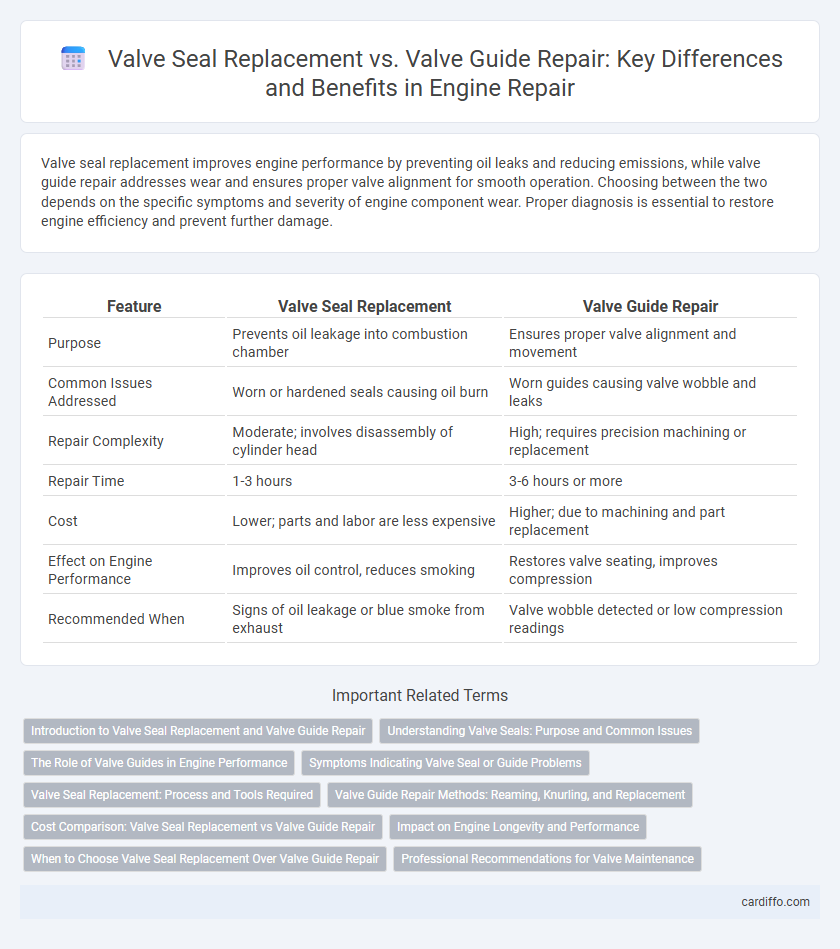Valve seal replacement improves engine performance by preventing oil leaks and reducing emissions, while valve guide repair addresses wear and ensures proper valve alignment for smooth operation. Choosing between the two depends on the specific symptoms and severity of engine component wear. Proper diagnosis is essential to restore engine efficiency and prevent further damage.
Table of Comparison
| Feature | Valve Seal Replacement | Valve Guide Repair |
|---|---|---|
| Purpose | Prevents oil leakage into combustion chamber | Ensures proper valve alignment and movement |
| Common Issues Addressed | Worn or hardened seals causing oil burn | Worn guides causing valve wobble and leaks |
| Repair Complexity | Moderate; involves disassembly of cylinder head | High; requires precision machining or replacement |
| Repair Time | 1-3 hours | 3-6 hours or more |
| Cost | Lower; parts and labor are less expensive | Higher; due to machining and part replacement |
| Effect on Engine Performance | Improves oil control, reduces smoking | Restores valve seating, improves compression |
| Recommended When | Signs of oil leakage or blue smoke from exhaust | Valve wobble detected or low compression readings |
Introduction to Valve Seal Replacement and Valve Guide Repair
Valve seal replacement restores proper engine oil control by preventing oil leakage into combustion chambers, ensuring efficient engine performance and reduced emissions. Valve guide repair addresses wear or damage to the valve guides, maintaining precise valve alignment and smooth engine operation. Both repairs are essential for engine durability, but valve seal replacement primarily focuses on oil sealing, while valve guide repair targets mechanical stability of the valve movement.
Understanding Valve Seals: Purpose and Common Issues
Valve seals prevent oil from leaking into the engine's combustion chamber, ensuring proper lubrication and minimizing emissions. Over time, valve seals can harden or crack, leading to oil consumption and smoke from the exhaust. Valve guide repair addresses wear in the valve stems' alignment, but replacing valve seals specifically resolves oil leakage and maintains engine performance.
The Role of Valve Guides in Engine Performance
Valve guides play a critical role in maintaining the alignment and stability of valve stems, directly impacting engine efficiency and performance. Worn or damaged valve guides cause increased oil consumption, reduced compression, and elevated emissions, which often necessitates timely repair or replacement. Choosing between valve seal replacement and valve guide repair depends on the extent of wear, with guide repairs essential for restoring precise valve movement and optimal combustion.
Symptoms Indicating Valve Seal or Guide Problems
Leaking valve seals often cause excessive oil consumption and blue smoke from the exhaust during engine start or acceleration. Worn valve guides typically result in engine misfires, rough idling, and increased valve stem movement visible during inspection. Diagnosing these symptoms early ensures timely valve seal replacement or valve guide repair, preventing further engine damage.
Valve Seal Replacement: Process and Tools Required
Valve seal replacement involves removing the valve spring and old seals to prevent oil leakage into the combustion chamber, crucial for maintaining engine performance and reducing emissions. Essential tools include a valve spring compressor, screwdriver set, pliers, and a magnet to safely extract and install new seals without damaging the valve components. Proper sealing enhances engine efficiency and longevity by ensuring optimal valve operation and preventing oil burning.
Valve Guide Repair Methods: Reaming, Knurling, and Replacement
Valve guide repair methods include reaming, knurling, and replacement, each tailored to restore proper valve stem alignment and reduce oil consumption. Reaming involves enlarging the worn guide to fit an oversized valve stem or insert a new guide sleeve for precise alignment. Knurling reshapes the existing guide by rolling grooves to increase diameter and improve the press-fit of the valve stem, while complete guide replacement offers the most effective solution for severely worn or damaged guides.
Cost Comparison: Valve Seal Replacement vs Valve Guide Repair
Valve seal replacement typically costs between $150 and $300, focusing on preventing oil leaks and improving engine performance. Valve guide repair is usually more expensive, ranging from $300 to $700, due to the complexity of machining and fitting new guides. Choosing between the two depends on the specific wear and damage, but valve seals generally offer a more affordable maintenance option.
Impact on Engine Longevity and Performance
Valve seal replacement directly prevents oil leakage into the combustion chamber, reducing carbon buildup and maintaining optimal compression, which enhances engine longevity and performance. Valve guide repair improves the alignment and movement of the valve stem, minimizing valve wear and ensuring proper valve seating, crucial for maintaining engine efficiency and reducing emissions. Neglecting either repair can lead to increased oil consumption, power loss, and accelerated engine wear, significantly impacting overall reliability and performance.
When to Choose Valve Seal Replacement Over Valve Guide Repair
Valve seal replacement is preferred when oil consumption increases or blue smoke appears during engine operation, indicating worn or hardened seals. Valve guide repair is more suitable if there is excessive valve stem play causing misalignment or noise. Choosing valve seal replacement over valve guide repair improves engine efficiency by preventing oil leakage without the complexity of guide shaft machining.
Professional Recommendations for Valve Maintenance
Professional recommendations for valve maintenance emphasize replacing valve seals over repairing valve guides when addressing oil leakage and combustion inefficiency. Valve seal replacement ensures a precise fit and restores proper sealing to prevent oil from entering the combustion chamber, while valve guide repair may only temporarily address alignment issues without fully resolving wear-related problems. Maintaining optimal valve performance often requires prioritizing seal replacement to enhance engine longevity and reduce emissions.
Valve seal replacement vs valve guide repair Infographic

 cardiffo.com
cardiffo.com